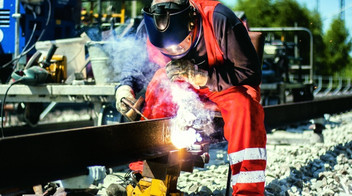Transformation into a high-performance network
In June 2022, the BMDV and DB Group presented plans for a new high-performance network to sustainably increase the quality and reliability of the infrastructure. The high-performance network will include the most highly utilized rail connections in Germany. Due to the forecasted traffic development, it will span over 9,000 km in length by the end of the decade.
One instrument for the transformation into the high-performance network are general modernizations, replacing and improving all outdated and disruption-prone installations. Two decisive and new elements are applicable to the general modernization of the highly utilized routes:
- Consolidation of all future upcoming construction work across all crafts, and
- increasing (residual) performance capability.
The purpose of increasing performance capability is to improve the capacity of a line for planned operations and to increase the operating quality, while the increase in residual performance capability is aimed at increasing capacity in the event of a disruption and improving the redundancy of the infrastructure.
The experience gained from the general modernization of the highly utilized network involving greater consolidation, improved equipment standards, and small and medium-sized measures for rapid capacity expansion should also be applied to the rest of the network wherever possible and sensible.
The general modernization of the first rail corridor will begin in 2024 with the Riedbahn (Mannheim — Frankfurt line). The Emmerich — Oberhausen and Hamburg — Berlin sections have been selected for 2025. In a multi-month joint process with industry actors, DB Netz AG (now DB InfraGO AG) derived criteria for the selection and timing of the general modernization measures. The resulting proposal for further succession from 2026 is available to the BMDV and is the subject of intensive discussions. The general modernizations will gradually increase the reliability and (residual) performance capability of the infrastructure and improve punctuality.
High-performance maintenance
Another instrument for transformation is the introduction of a new operations regime. The entire high-performance network will be managed step-by-step using optimized maintenance with four essential levers.
A high-performance prevention approach will ensure consistent preventive maintenance on the high-performance network based on data and intelligent life cycle models. Dedicated control centers are being set up in the regions with a direct connection to the operational ground staff to ensure particularly rapid intervention. In addition, the internal on-call workforce is being strengthened and further locations for rail crossing points will be set up. As part of a digitalization campaign, maintenance is supported by the extensive use of sensors and forecasts.
The increase in the preventive maintenance budget by € 2.6 billion in the period from 2024 to 2030 is predicted to stabilize and improve the situation already in the short term. The ongoing rollout of the first sensors and the creation of a first control center are expected to increase availability.


